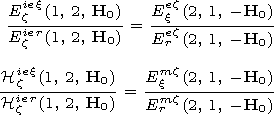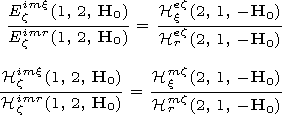H0) are the
x components of
the fields excited in the ionosphere at the point 1 under the
geomagnetic field
- H0 by electric or magnetic dipoles
directed along
ez and located in the waveguide at
the point 2. In this case
z takes the values
r,
q,
and
j.
[20] It follows from expressions (33) and (34) and relations (23),
(30), and (31) that the formulae relating the components of the
fields excited in the waveguide cavity by emitters of different
types located in the ionosphere in the region, where
quasi-longitudinal approximation (22) and inequalities (27) are
applicable, can be written in matrix form as
 | (35) |
 | (36) |
 | (37) |
Here
Aiqx ( q=e, m; x=r, q, j )
are six-element column matrices of the modules of the electric and
magnetic field components and
e and
m according to
formulae (30) and (31) are
 | (38) |
 | (39) |
Here
b=a+H, where
H is the height of the emitter above the
surface of the ground. It is seen that (39) may be written as
where
N and
H0 L should be given in el cm
-3 and
oersteds, respectively.
[21] In the case of an irregular waveguide, the parameters in formulae
(38) and (39) describing the ionospheric properties correspond to
the point at which the emitter is located.

Powered by TeXWeb (Win32, v.2.0).









